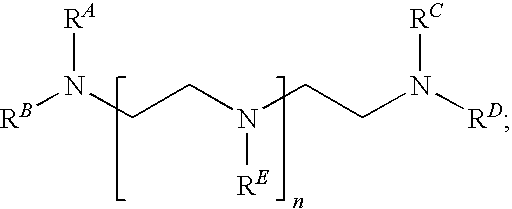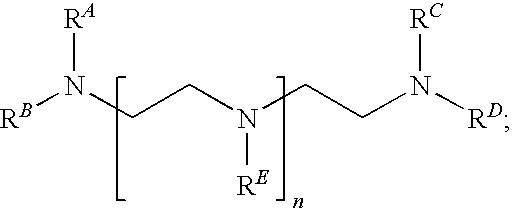Benzylated Polyalkylene Polyamines And Uses Thereof
a technology of benzylated polyalkylene polyamine and polyamine, which is applied in the direction of synthetic resin layered products, transportation and packaging, chemistry apparatus and processes, etc., can solve the problems of amine migration to the coating surface, intercoat adhesion problems, and many epoxy coatings based on eda homologues suffer from problems, so as to improve compatibility with epoxy resin, reduce smoking or fuming, and improve the effect of compatibility
- Summary
- Abstract
- Description
- Claims
- Application Information
AI Technical Summary
Benefits of technology
Problems solved by technology
Method used
Image
Examples
example 1
Synthesis of Benzylated Diethylenetriamine (DETA) at a 1.2:1 Molar Ratio
[0086]340.6 g of DETA (3.24 moles) and 5 g of Pd / C catalyst were placed in a 1-liter autoclave batch reactor. The reactor was sealed and subsequently purged with nitrogen and then with hydrogen to remove any air from the reactor. Over about 15 to 20 minutes, 420.2 g of benzaldehyde (3.96 moles) were added to the reactor. After the addition of the benzaldehyde was complete, the reactor contents were stirred for an additional 15 minutes or until the reaction was complete, at which time the reaction exotherm began to subside. At this point, the reactor was pressurized to 0.8.2 MPa (120 psi) with hydrogen and the reactor was heated to 80° C. When the rate of hydrogen uptake slowed, the pressure was increased to 5.44 MPa (800 psi) and the temperature was increased to 120° C. The hydrogenation process continued until the rate of hydrogen uptake fell below 0.0034 MPa / min (0.5 psi / min). The total hydrogenation time was ...
examples 2-3
Synthesis of Benzylated Diethylenetriamine (DETA) at Varying Molar Ratios
[0087]Examples 2-3 utilized the same process as described in Example 1. The molar ratio of benzaldehyde to DETA was 1.5:1 for Example 2 and 2:1 for Example 3. These reactant ratios are indicated by the degree of alkylation in Table 1 which also shows the resulting viscosity, AHEW, theoretical amine value, and actual (measured) amine value properties.
examples 4-6
Synthesis of Benzylated Triethylenetetramine (TETA) at Varying Molar Ratios
[0088]Example 4 to 6 utilized the same process as described in Example 1, but with TETA as the polyalkylene polyamine compound. The molar reactant ratios are indicated by the degree of alkylation in Table 1 which also shows the resulting viscosity, AHEW, theoretical amine value, and actual (measured) amine value properties.
TABLE 1Synthesis of Benzylated Polyalkylene PolyaminesExample123Amine(s) usedDETADETADETAAmine ratio100100100Degree of benzylation1.2:11.5:12:1Amine quantity (g)340.6309.6240.5Benzaldehyde (g)420.2477495Pd / C catalyst (g)56.23.6Viscosity at 25° C. (mPa · s)30.236.449.1AHEW51.86894.3Theoretical Amine value797707595(mg KOH / g)Actual Amine value776697600(mg KOH / g)Example456Amine(s) usedTETATETATETAAmine ratio100100100Degree of benzylation1.1:11.5:12:1Amine quantity (g)292292326.7Benzaldehyde (g)233318497.8Pd / C catalyst (g)5.05.010 g (Pt / C)Viscosity at 25° C. (mPa · s)98.0135423AHEW516282Theoreti...
PUM
| Property | Measurement | Unit |
|---|---|---|
| Fraction | aaaaa | aaaaa |
| Temperature | aaaaa | aaaaa |
| Temperature | aaaaa | aaaaa |
Abstract
Description
Claims
Application Information
 Login to View More
Login to View More - R&D
- Intellectual Property
- Life Sciences
- Materials
- Tech Scout
- Unparalleled Data Quality
- Higher Quality Content
- 60% Fewer Hallucinations
Browse by: Latest US Patents, China's latest patents, Technical Efficacy Thesaurus, Application Domain, Technology Topic, Popular Technical Reports.
© 2025 PatSnap. All rights reserved.Legal|Privacy policy|Modern Slavery Act Transparency Statement|Sitemap|About US| Contact US: help@patsnap.com



